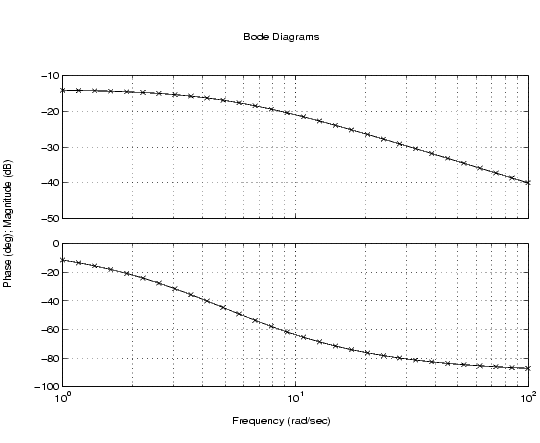

| Control System Toolbox Function Reference |   |
Input/output balancing of state-space realizations
Syntax
sysb = balreal(sys) [sysb,g,T,Ti] = balreal(sys)
Description
sysb = balreal(sys)
produces a balanced realization sysb of the LTI model sys with equal and diagonal controllability and observability grammians (see gram for a definition of grammian). balreal handles both continuous and discrete systems. If sys is not a state-space model, it is first and automatically converted to state space using ss.
[sysb,g,T,Ti] = balreal(sys)
g containing the diagonal of the balanced grammian, the state similarity transformation  used to convert
used to convert sys to sysb, and the inverse transformation .
.
If the system is normalized properly, the diagonal g of the joint grammian can be used to reduce the model order. Because g reflects the combined controllability and observability of individual states of the balanced model, you can delete those states with a small g(i) while retaining the most important input-output characteristics of the original system. Use modred to perform the state elimination.
Example
Consider the zero-pole-gain model
sys = zpk([-10 -20.01],[-5 -9.9 -20.1],1) Zero/pole/gain: (s+10) (s+20.01) ---------------------- (s+5) (s+9.9) (s+20.1)
A state-space realization with balanced grammians is obtained by
[sysb,g] = balreal(sys)
The diagonal entries of the joint grammian are
g' ans = 1.0062e-01 6.8039e-05 1.0055e-05
which indicates that the last two states of sysb are weakly coupled to the input and output. You can then delete these states by
sysr = modred(sysb,[2 3],'del')
to obtain the following first-order approximation of the original system.
zpk(sysr) Zero/pole/gain: 1.0001 -------- (s+4.97)
Compare the Bode responses of the original and reduced-order models.
bode(sys,'-',sysr,'x')

Algorithm

with controllability and observability grammians  and
and  . The state coordinate transformation
. The state coordinate transformation  produces the equivalent model
produces the equivalent model

and transforms the grammians to

The function balreal computes a particular similarity transformation  such that
such that

See [1,2] for details on the algorithm.
Limitations
The LTI model sys must be stable. In addition, controllability and observability are required for state-space models.
See Also
gram Controllability and observability grammians
minreal Minimal realizations
modred Model order reduction
References
[1] Laub, A.J., M.T. Heath, C.C. Paige, and R.C. Ward, "Computation of System Balancing Transformations and Other Applications of Simultaneous Diagonalization Algorithms," IEEE Trans. Automatic Control, AC-32 (1987), pp. 115-122.
[2] Moore, B., "Principal Component Analysis in Linear Systems: Controllability, Observability, and Model Reduction," IEEE Transactions on Automatic Control, AC-26 (1981), pp. 17-31.
[3] Laub, A.J., "Computation of Balancing Transformations," Proc. ACC, San Francisco, Vol.1, paper FA8-E, 1980.
 | augstate | bode |  |